Bryan L. Programmable controllers. Theory and implementation
Подождите немного. Документ загружается.

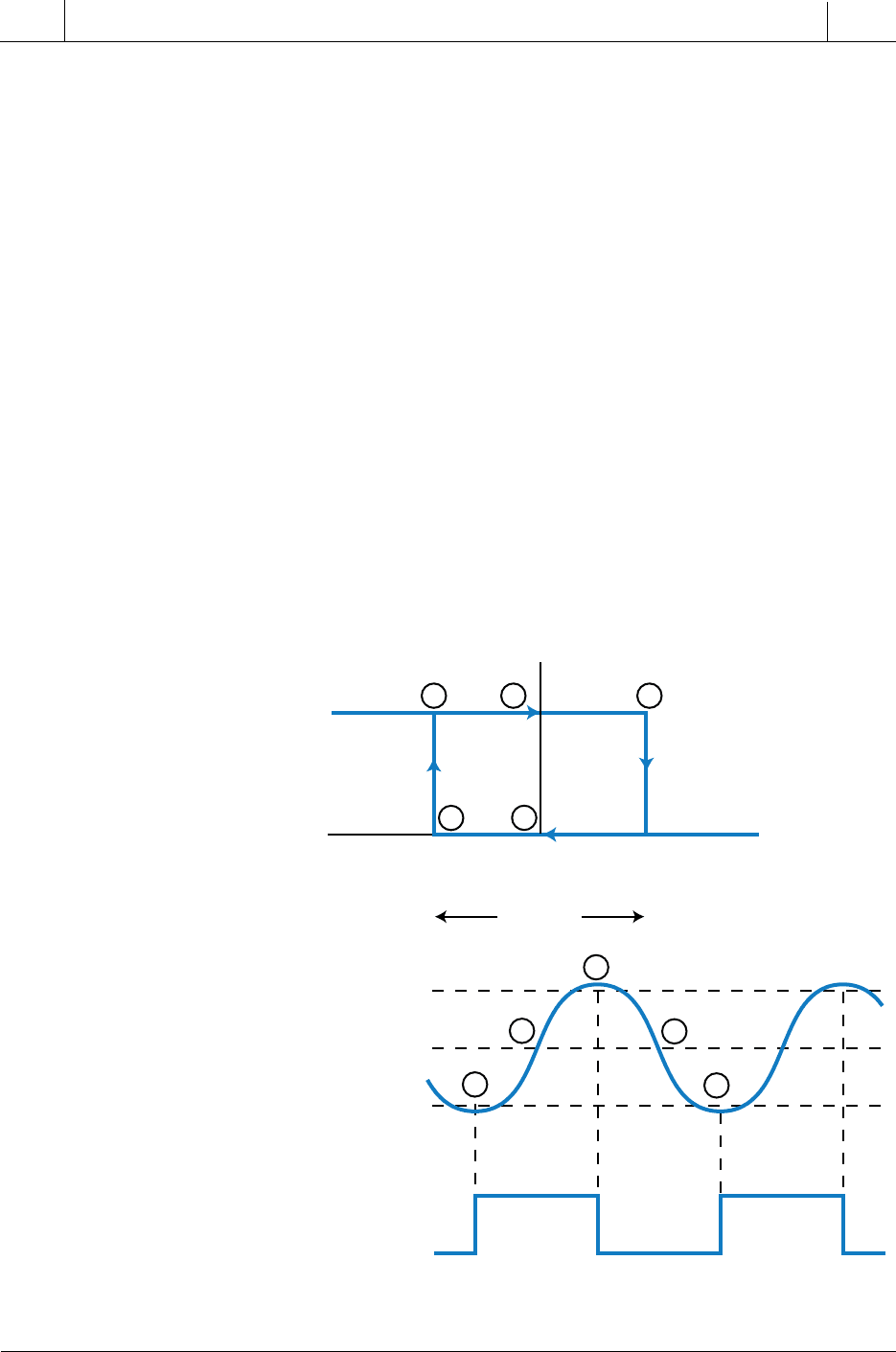
679
CHAPTER
15
Process Controllers
and Loop Tuning
SECTION
4
PLC Process
Applications
Industrial Text & Video Company 1-800-752-8398
www.industrialtext.com
on the direction of the process variable. If the value of the process variable is
decreasing within the deadband, then the controller is OFF, since it senses
that the temperature is still at an acceptable level (reverse-acting). When the
process variable reaches the lower limit of the deadband, then the controller
will turn ON, causing the direction of the process variable to change (i.e., to
increase). The controller will remain ON until PV reaches the upper limit of
the deadband. At that time, the controller will turn OFF, PV will begin to
decrease, and the cycle will repeat.
The action of an ON/OFF controller can be described by:
CV E
CV E
=>−
=<+
100
0
%
%
(ON) IF error
(OFF) IF error
∆
∆
where ±∆E represents the error deadband. Graphically, this controller output
can be represented as shown in Figure 15-13, where the deadband of ±∆E is
equal to ±2°F. If the process variable “comes” from the positive side (i.e., the
error declines to a value less than –∆E, or 68°F), the controller output will turn
ON at point 1 and remain ON (point 2) until the error reaches +∆E (point 3).
SP
+ ∆
E
Set Point
SP
– ∆
E
PV
CV
1
1 2 3
5
4
2
4
5
Error
–∆
E
68°
+∆
E
72°
E
= 0
70°
Controller Output
Acceptable
Range
ON
OFF
72°
70°
68°
ON
OFF
3
Figure 15-13. Controller output of the heating process.

680
SECTION
4
PLC Process
Applications
Industrial Text & Video Company 1-800-752-8398
www.industrialtext.com
CHAPTER
15
Process Controllers
and Loop Tuning
At that time, the controller will turn OFF and remain OFF (through point 4)
until the error drops to –∆E (point 5), causing the cycle to repeat. This
deadband curve is said to have hysteresis, meaning that the reaction of the
system depends on its previous actions. It also produces an oscillating
response, which is acceptable in this case. Also note that the curve of the
ON/OFF controller signal will tend to overshoot the SP + ∆E value and
undershoot the SP – ∆E value of the heater system due to finite warm up and
cool off times (lag times).
ON/OFF controllers are appropriate for applications where large-scale,
sudden changes are uncommon and the process reaction rate is slow. If the
error deadband of the controller is reduced, then the amount of error in the
system will decrease; however, the frequency of the ON/OFF and process
variable cycles will increase. Conversely, if the deadband is increased, the
oscillation frequency will decrease, but the error will be maximized. Thus, a
trade-off exists between the desired error deadband and the frequency of the
ON/OFF activation of the control element. The control element (e.g., valve,
compressor, etc.) and other system components may be seriously damaged if
they are turned ON and OFF too rapidly. Therefore, the system must be
configured to compromise between the error allowance and the frequency
of oscillation.
EXAMPLE 15-1
A two-position discrete-mode controller controls a cooling system,
maintaining the system at a set point of 70°F. The controller has a
deadband of ±3°F to allow for deviations from the set point.
(a) Plot the relationship between the controller’s ON/OFF output, the
process variable response, and the error curve, disregarding any
overshoot or undershoot conditions. (b) Determine whether this is a
direct- or reverse-acting controller.
S
OLUTION
(a) Figure 15-14a illustrates the response of the process variable
(temperature) to the controller’s ON/OFF output. Figure 15-14b
shows the hysteresis curve of the controller output versus the error.
(b) This controller is a direct-acting one, because as the process
variable increases (passes +∆
E
of
SP
), the controller will increase the
control variable from 0% (OFF) to 100% (ON).
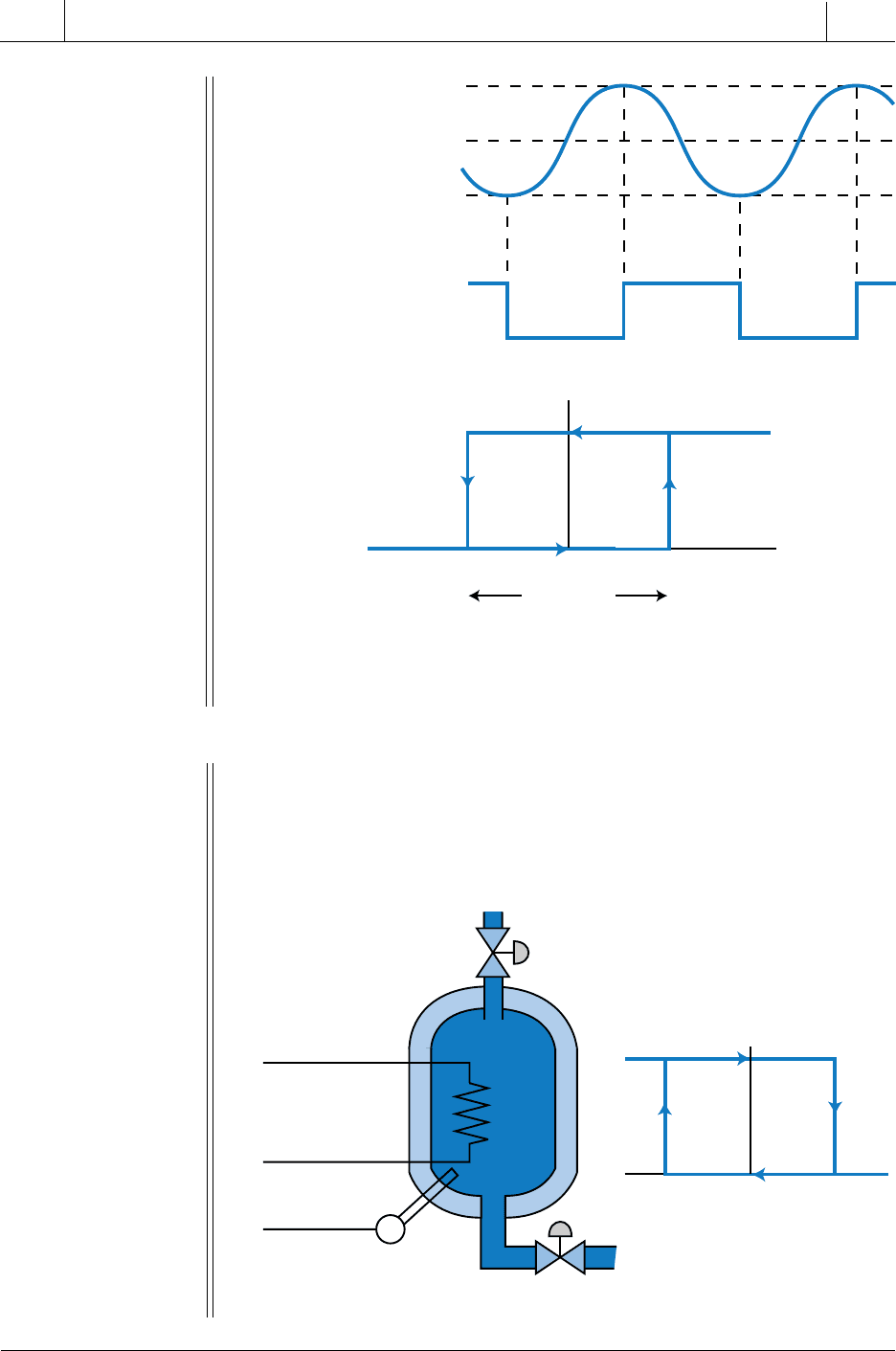
681
CHAPTER
15
Process Controllers
and Loop Tuning
SECTION
4
PLC Process
Applications
Industrial Text & Video Company 1-800-752-8398
www.industrialtext.com
Figure 15-14. Example 15-1 (a) process variable response and (b) hysteresis curve.
EXAMPLE 15-2
Figure 15-15 shows a mixer tank that is heated by an ON/OFF heating
control system. The set point temperature is 200°F with a deadband
deviation of ±5% from the set point. When the heater is not on, the
Temperature
Feedback
Heater
ON/OFF
Set Point = 200°F
Deadband = ±5%
–∆
E
190°
+∆
E
210°
E
= 0
200°
CV
Figure 15-15. Mixer tank heated by an ON/OFF control system.
SP
+ ∆
E
Set Point
SP
– ∆
E
PV
CV
(a)
73°
70°
67°
ON
OFF
Error
–∆
E
+∆
EE
= 0
Controller Output
Deadband
ON
OFF
(b)
CV
= 100% IF error > +∆
E
(IF Hot : Temp > 73°F)
CV
= 0% IF error < –∆
E
(
IF Cool : Temp > 67°F
)

682
SECTION
4
PLC Process
Applications
Industrial Text & Video Company 1-800-752-8398
www.industrialtext.com
CHAPTER
15
Process Controllers
and Loop Tuning
system linearly loses (cools) 4°F per minute; when the heater is
applied, the system gains 8°F per minute. The system starting point is
at the set point temperature with the heater in the OFF mode.
(a) Plot the oscillation response (cycle period) of the system and
controller, and (b) calculate the response in part (a) taking into
consideration a heater lag time of 30 seconds (0.5 min).
S
OLUTION
(a) Figure 15-16 illustrates the response of the process variable over
time, along with the controller’s output status. The upper value of the
deadband (∆
E
= +5%) is 210°F, while the lower value (∆
E
= –5%) is
190°F. This curve starts at 200°F (
SP
) and declines at a rate of 4°F/min
until the temperature equals 190°F (
SP
– ∆
E
). At 190°F, the controller
turns ON and starts heating the system at a rate of 8°F/min until the
temperature reaches 210°F (
SP
+ ∆
E
), at which point, the controller
turns off the heater. The process variable starts to cool off again at the
rate of 4°F/min until the temperature reaches
SP
– ∆
E
, where the cycle
is repeated.
Figure 15-16. Process variable response for Example 15-2.
This system’s response curve can be represented by two equations,
one for when the controller is OFF and another for when the controller
is ON:
Temp Temp (OFF mode)
Temp Temp (ON mode)
(t
(t
1
2
14
28
1
2
() )
() )
–( )
()
t
t
tt
tt
=−+
=−+
SP
+ ∆
E
= 210°
Set Point = 200°
SP
– ∆
E
= 190°
ON
OFF
t
One Cycle
2.5
min
2.5
min
2.5
min
t
= 2.5
t
= 5
t
= 7.5
Rate of Cooling
4°/min
Rate of Heating
8°/min
Controller’s
Output
PV

683
CHAPTER
15
Process Controllers
and Loop Tuning
SECTION
4
PLC Process
Applications
Industrial Text & Video Company 1-800-752-8398
www.industrialtext.com
where:
Temp thevalueof the curve(temperature) when the
controlleris OFF
Temp the value of the curve whenthe controller is ON
Temp the value of at time
Temp the value of at time
time
1
2
1
2
1
2
()
()
()
()
t
t
t
t
PV
PV
PV t
PV t
t
=
=
=
=
=
Note that the first curve has a slope of –4°F/min and that the second
curve has a slope of +8°F/min. So, the time required to reach
SP
– ∆
E
(190°) at
t
1
= 0 and
Temp
(
t
1
)
= 200° is:
Temp Temp
(t
1
14
190 4 0 200
190 4 200
410
10
4
25
1() )
–( )
–( )
–
. min
t
tt
t
t
t
t
=−+
=−+
=+
=
==
At 2.5 minutes, the controller will turn ON. So, knowing that Temp2
(
t
)
is
equal to 190°F at
t
= 2.5, we need to find the time at
t
2
.
Temp
(
t
2
)
is equal
to 210°F, because that is the time when the controller will turn OFF
again; therefore:
Temp Temp
(
2
28
190 8 2 5 210
190 20 8 210
840
40
8
5
2
2
2
2
2
() )
()
(. )
min
tt
tt
t
t
t
t
=−+
=−+
=−+
=
==
So, the temperature value will be 210°F when
t
= 5 minutes. Thus, the
time from the moment the controller turns ON the heater at
SP
– ∆
E
(190°F) to the moment the controller turns OFF the heater at
SP
+ ∆
E
(210°F) is 2.5 minutes. This is the time at 210°F minus the time it took
to get to 190°F (5 min – 2.5 min = 2.5 min).
To complete the calculation of the oscillation cycle period, we must
find the amount of time required for the temperature to cool off to the
set point value again. This is equal to half of the time it takes for the

684
SECTION
4
PLC Process
Applications
Industrial Text & Video Company 1-800-752-8398
www.industrialtext.com
CHAPTER
15
Process Controllers
and Loop Tuning
temperature to go from 210° to 190°. This value is the same as the
time calculated for the curve Temp1
(
t
)
, which is 2.5 minutes. Therefore,
the frequency of oscillation will be 7.5 minutes.
Another way to calculate the time for each curve is to determine the
difference between the temperatures and divide this difference by the
rate required to get from one temperature to another. The time required
for the first half of the curve, the OFF mode, to decline from the set point
(200°F) to the lower limit of the deadband (190°F) is:
200 190 4
10 4
10
4
25
°→ ° −°
−° −°
=
−°
−°
=
F F rate F
F change rate F
F
F
@ /min
@ /min
/min
. min
t
The same calculation for the OFF-to-ON state of the controller is:
190 210 8
20 8
20
8
25
°→ ° °
°°
=
°
°
=
F F rate F
F change rate F
F
F
@ /min
@ /min
/min
. min
t
Finally, the time required for the next part of the curve is:
210 190 4
20 4
20
4
5
°→ ° −°
−° −°
=
−°
−°
=
F F rate F
F change rate F
F
F
@ /min
@ /min
/min
min
t
However, to compute the oscillation period, the system only requires
half of this last time calculation, 2.5 minutes, to complete the cycle (i.e.,
return to the set point). Thus, the total time for the oscillation response
is 7.5 min (2.5 min + 2.5 min + 2.5 min).
(b) A lag of 30 seconds, or 0.5 minutes, will cause the ON/OFF response
to undershoot and overshoot the deadband, slightly affecting the
frequency of oscillation (see Figure 15-17). This 0.5-minute lag may be
due to the cooling off and heating up times associated with the heating
element. The oscillation frequency for the first part of the curve can be
calculated as follows:
200 190 4
10
4
25
°→ ° −°
=
−°
−°
=
F F rate F
F
F
@ /min
/min
. min
t
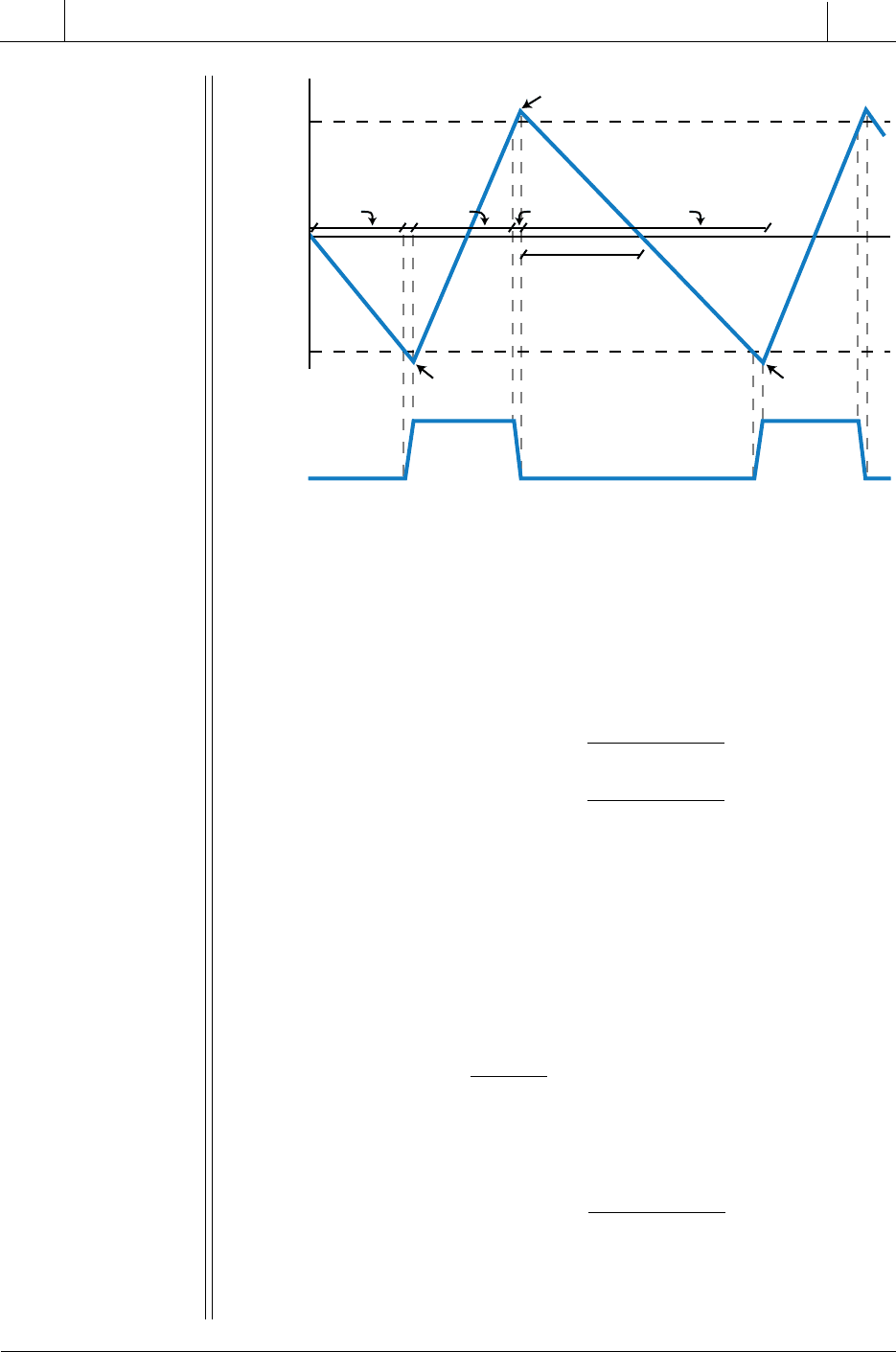
685
CHAPTER
15
Process Controllers
and Loop Tuning
SECTION
4
PLC Process
Applications
Industrial Text & Video Company 1-800-752-8398
www.industrialtext.com
Figure 15-17. Undershoot and overshoot of the error deadband due to lag.
However, once the temperature reaches 190°F and the heater turns
ON, another 0.5 minutes will elapse while the heating element heats
up. Meanwhile, the temperature will continue to drop. So, during that
0.5-minute lapse, the temperature will drop another 2°F; making the
final low-limit temperature 188°F:
t
=
=
−°
=−=−°
°−°= °
∆
∆
∆
temperature
rate
temperature
F
temperature F
FF F
05
4
05 4 2
190 2 188
. min
/min
( . )( )
This lag will cause an undershoot of the deadband. Once the
controller is ON, it will heat the tank at a rate of 8°F/min, reaching the
210°F upper temperature level in 2.75 minutes:
188 210 8
22
8
275
°→ ° °
=
°
°
=
F F rate F
F
F
@ /min
/min
. min
t
The 0.5-minute lag will cause an overshoot of 4°F:
05
8
05 8
4
. min
/min
( . )( )
=
°
=
=°
∆
∆
temperature
F
temperature
F
210°
200°
190°
ON
OFF
t
2.5 0.5 2.75 6.5 min0.5
3.25 min
188°F
214°F
188°F

686
SECTION
4
PLC Process
Applications
Industrial Text & Video Company 1-800-752-8398
www.industrialtext.com
CHAPTER
15
Process Controllers
and Loop Tuning
This will make the upper temperature 214°F (210°F + 4°F). The final
period of oscillation, which is the last half of the curve, is the cooling
off period between the upper temperature limit (214°F) and the lower
limit (188°F):
214 188 4
26
4
65
°→ ° °
=
°
°
=
F F rate F
F
F
@ /min
/min
. min
t
The half point of this curve, where
PV
equals the set point, will occur
at 3.25 minutes. Thus, the total period of this system with lag, as
shown in Figure 15-17, is:
Period =+ + + +
=
( . min . min) ( . min . min) . min
. min
25 05 275 05 325
95
The addition of a 0.5-minute lag to this system will increase the
frequency from 7.5 minutes to 9.5 minutes.
THREE-POSITION DISCRETE CONTROLLERS
A three-position controller provides three output levels, instead of just two
output levels like a two-position controller. Basically, this controller has an
additional ON setting at 50% of the full ON range. The use of a three-position
controller tends to reduce the cycling behavior of the process variable because
it provides an intermediate output level, rather than just the two level settings
of an ON/OFF controller. The controller stops at the intermediate 50% setting
when the set point is achieved. In fact, a controller’s output is usually
designed so that its half output, or 50%, coincides with the level required by
the process to maintain the process variable at the set point, minimizing the
error in the system. Figure 15-18 illustrates a three-position, direct-acting
controller’s output (CV) according to the error present in the system. This
output can be represented mathematically as:
CV E
CV E E
CV E
=>+
=−<<+
=<−
100
50
0
%
%
%
IF error
IF error
IF error
∆
∆∆
∆
Because three-position field devices are not as widely available as two-
position ON/OFF devices, analog field devices are often used to implement
three-position control. A PLC may also implement a three-position output
using a contact output interface (see Figure 15-19). The incoming sides of
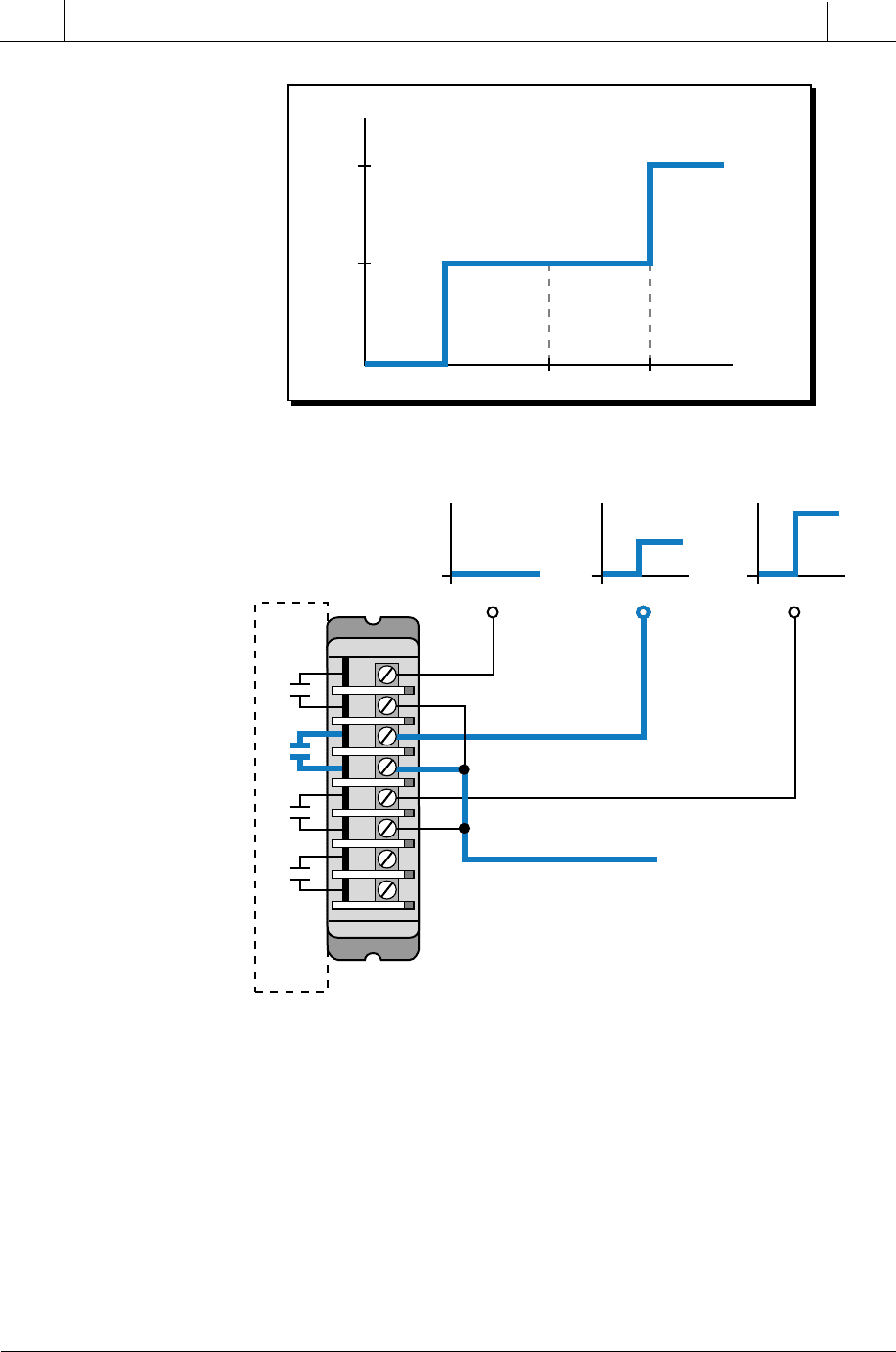
687
CHAPTER
15
Process Controllers
and Loop Tuning
SECTION
4
PLC Process
Applications
Industrial Text & Video Company 1-800-752-8398
www.industrialtext.com
Figure 15-18. Three-position, direct-acting controller’s output in response to error.
Figure 15-19. Contact output interface implementing three-position control.
100%
50%
0%
E
= –∆
EE
= +∆
EE
= 0
Error
CV
1A
1B
2A
2B
3A
3B
4A
4B
Inside
Module
To three-position
mode field device
0% Power 50% Power 100% Power
100%
50%
0%
100%
50%
0%
100%
50%
0%
three of the contact module’s terminals are connected to 0%, 50%, and 100%
power signals, respectively. The other sides of the contacts join together and
connect to the field device (e.g., valve). In this configuration, a PLC with a
contact output module can be interfaced with analog signals set at 0%, 50%,
and 100% of the full range of the field control device to implement three-
position control. Discrete-mode controllers with more than three positions
(e.g., five positions, multipositions, etc.) may also be implemented this way
in some control applications. Since output field devices with more than three
positions are not readily available, analog output devices are often used in
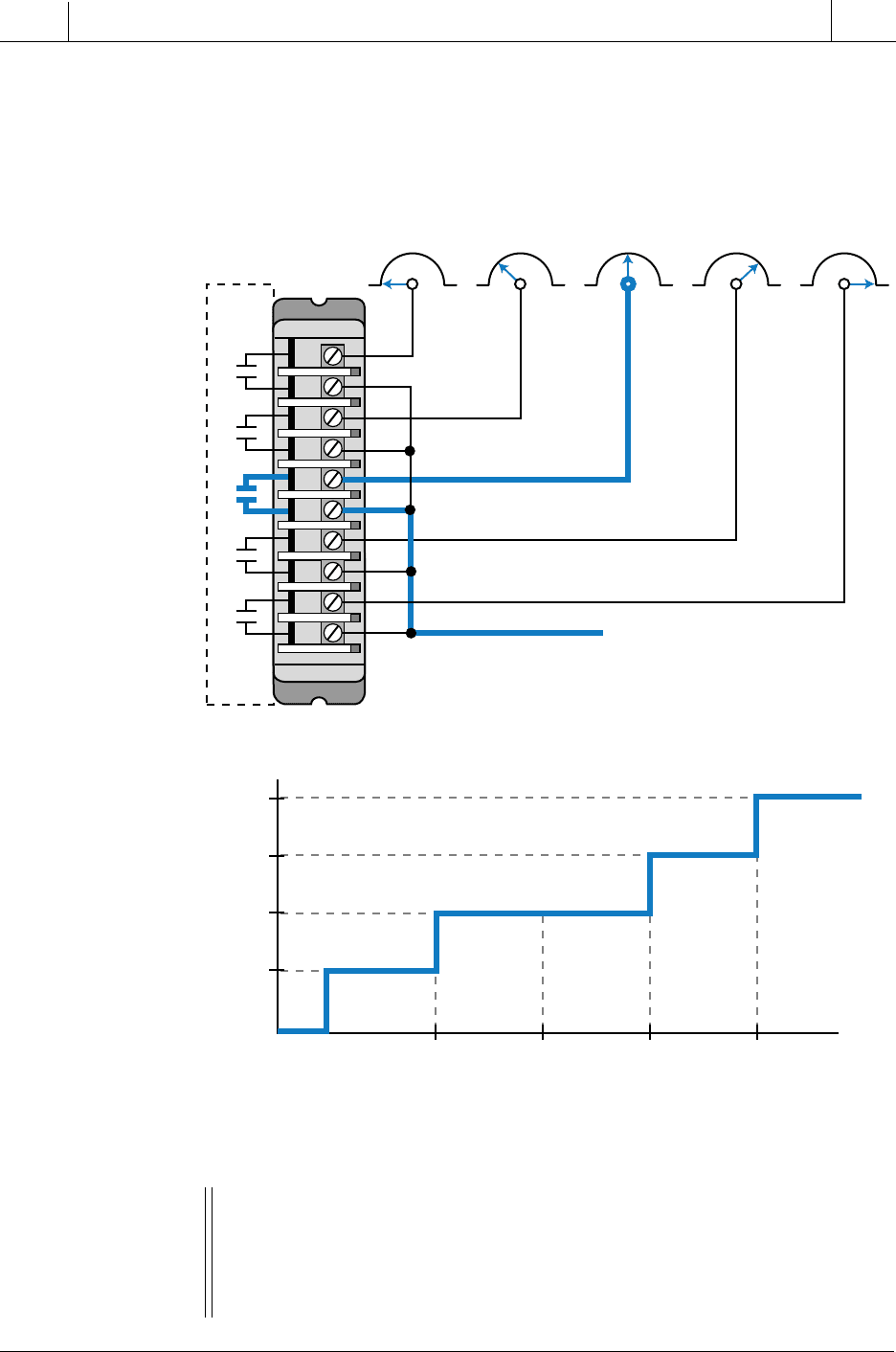
688
SECTION
4
PLC Process
Applications
Industrial Text & Video Company 1-800-752-8398
www.industrialtext.com
CHAPTER
15
Process Controllers
and Loop Tuning
Figure 15-20. (a) A discrete mode, multiposition controller and (b) its output.
conjunction with multiple output contact cards to obtain multiposition
control. Figure 15-20 illustrates an example of this type of direct-acting
control system with five possible output settings.
1A
1B
2A
2B
3A
3B
4A
4B
5A
5B
Inside
Module
Analog
Voltage
0% Reference
Analog
Voltage
25% Reference
Analog
Voltage
50% Reference
Analog
Voltage
75% Reference
Analog
Voltage
100% Reference
To analog control field device
100%
75%
50%
25%
0%
E
= –
E
2
E
= –
E
1
E
= 0
E
= +
E
1
E
= +
E
2
Error
CV
(a)
(b)
EXAMPLE 15-3
Graphically illustrate the reaction of a three-position controller output
to the steam heating system shown in Figure 15-21. Include the effect
of the controller’s lag.
